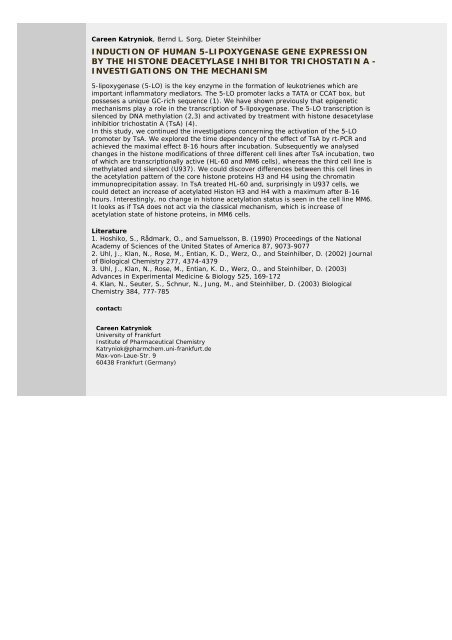Abstracts (poster) - Wissenschaft Online
Abstracts (poster) - Wissenschaft Online
Abstracts (poster) - Wissenschaft Online
Create successful ePaper yourself
Turn your PDF publications into a flip-book with our unique Google optimized e-Paper software.
Careen Katryniok, Bernd L. Sorg, Dieter Steinhilber<br />
INDUCTION OF HUMAN 5-LIPOXYGENASE GENE EXPRESSION<br />
BY THE HISTONE DEACETYLASE INHIBITOR TRICHOSTATIN A -<br />
INVESTIGATIONS ON THE MECHANISM<br />
5-lipoxygenase (5-LO) is the key enzyme in the formation of leukotrienes which are<br />
important inflammatory mediators. The 5-LO promoter lacks a TATA or CCAT box, but<br />
posseses a unique GC-rich sequence (1). We have shown previously that epigenetic<br />
mechanisms play a role in the transcription of 5-lipoxygenase. The 5-LO transcription is<br />
silenced by DNA methylation (2,3) and activated by treatment with histone desacetylase<br />
inhibitior trichostatin A (TsA) (4).<br />
In this study, we continued the investigations concerning the activation of the 5-LO<br />
promoter by TsA. We explored the time dependency of the effect of TsA by rt-PCR and<br />
achieved the maximal effect 8-16 hours after incubation. Subsequently we analysed<br />
changes in the histone modifications of three different cell lines after TsA incubation, two<br />
of which are transcriptionally active (HL-60 and MM6 cells), whereas the third cell line is<br />
methylated and silenced (U937). We could discover differences between this cell lines in<br />
the acetylation pattern of the core histone proteins H3 and H4 using the chromatin<br />
immunoprecipitation assay. In TsA treated HL-60 and, surprisingly in U937 cells, we<br />
could detect an increase of acetylated Histon H3 and H4 with a maximum after 8-16<br />
hours. Interestingly, no change in histone acetylation status is seen in the cell line MM6.<br />
It looks as if TsA does not act via the classical mechanism, which is increase of<br />
acetylation state of histone proteins, in MM6 cells.<br />
Literature<br />
1. Hoshiko, S., Rådmark, O., and Samuelsson, B. (1990) Proceedings of the National<br />
Academy of Sciences of the United States of America 87, 9073-9077<br />
2. Uhl, J., Klan, N., Rose, M., Entian, K. D., Werz, O., and Steinhilber, D. (2002) Journal<br />
of Biological Chemistry 277, 4374-4379<br />
3. Uhl, J., Klan, N., Rose, M., Entian, K. D., Werz, O., and Steinhilber, D. (2003)<br />
Advances in Experimental Medicine & Biology 525, 169-172<br />
4. Klan, N., Seuter, S., Schnur, N., Jung, M., and Steinhilber, D. (2003) Biological<br />
Chemistry 384, 777-785<br />
contact:<br />
Careen Katryniok<br />
University of Frankfurt<br />
Institute of Pharmaceutical Chemistry<br />
Katryniok@pharmchem.uni-frankfurt.de<br />
Max-von-Laue-Str. 9<br />
60438 Frankfurt (Germany)

















